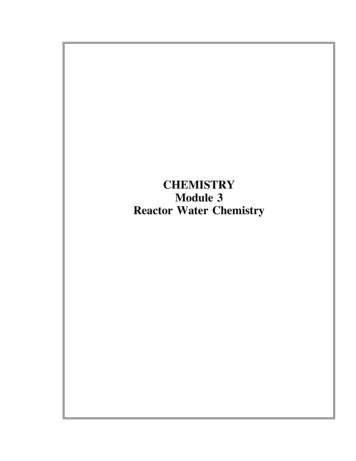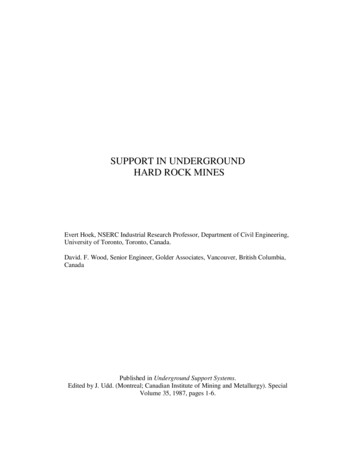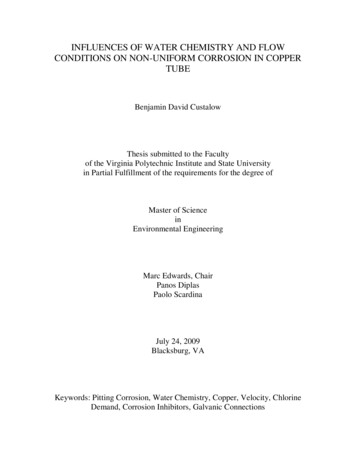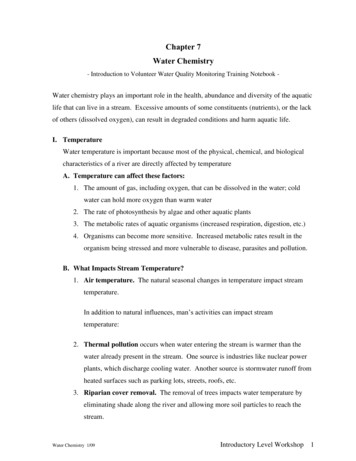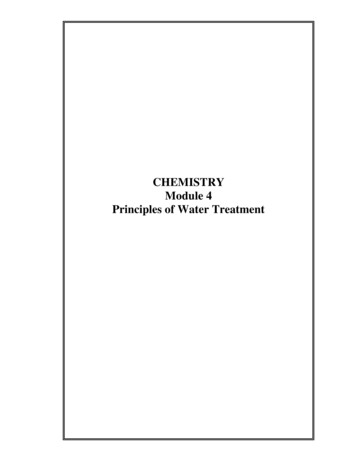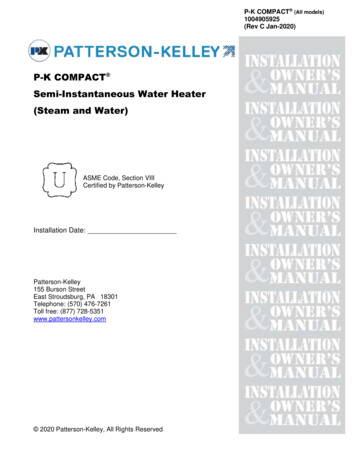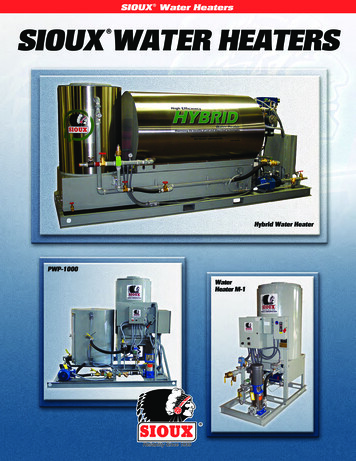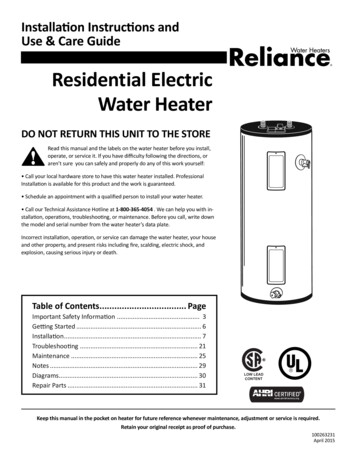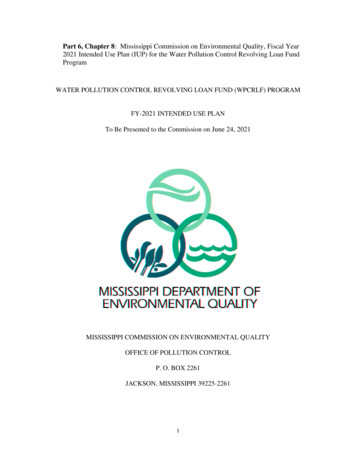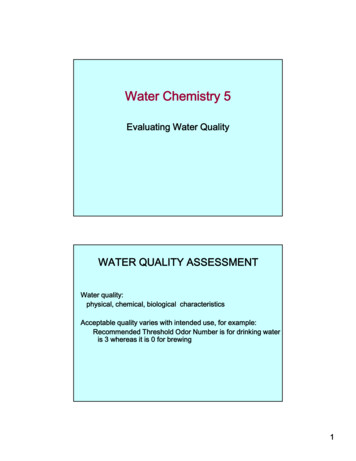
Transcription
Water Chemistry 5Evaluating Water QualityWATER QUALITY ASSESSMENTWater quality:physical, chemical, biological characteristicsAcceptable quality varies with intended use, for example:Recommended Threshold Odor Number is for drinking wateris 3 whereas it is 0 for brewing1
PHYSICAL CHARACTERISTICS: TurbidityTurbidity – the clarity of waterTransparency of natural water bodies is affected by humanactivity, decaying plant matter, algal blooms, suspendedsediments, and plant nutrientsTurbidityTbidit providesid an iinexpensivei estimateti t off totalt t l suspendedd dsolids TSS concentrationTurbidity has little meaning except in relatively clear waters butis useful in defining drinking-water quality in water treatmentSecchi disk measures how deep a person can see into the water(feet). Reflects euphotic zone. Can’t be used in shallow water.Other methods for measuring turbidity areJackson Turbidity Units (JTU) depth candle can be seenNephlometer Turbidity Units (NTU) light scattering from atungsten lamp (white light)Formazin Nephelometric Units (FNU) light scattering from an LED(light emitting diode, infrared) calibration uses microspheresof the polymer formazinUnits are roughly equivalentDuration of Turbidity is an Important turbidity.html2
Nephlometer Turbidity Units (NTU)PHYSICAL CHARACTERISTICS: ColorBlue - Transparent water with low dissolved solids3
PHYSICAL CHARACTERISTICS: ColorRed - An iron mine pit lake in northeast Minnesota(some algae cause red color)PHYSICAL CHARACTERISTICS: ColorLeft - Reddish-Orange - iron Precipitate from AMDRight - Reddish Silt in Malaysia River4
PHYSICAL CHARACTERISTICS: ColorGreen-Blue Tapajos meets the Brown-Yellow Amazon RiverBrown-Yellow dissolved organic materials, humic substancesfrom soil, peat, or decaying plant materialPHYSICAL CHARACTERISTICS: ColorGreen due to water rich in phytoplankton and other swan tlands/basics/importance.html5
PHYSICAL CHARACTERISTICS: ColorVerbal descriptions of color are unreliable and subjectiveEPA Secondary Drinking Water Recommendation is forcolor of less than 15 Platinum Cobalt Units (PCU)1 unit - the color of distilled water containing 1 milligram of platinum aspotassium chloroplatinate per literColor is reduced or removed from water through the use of coagulation,settling and filtration techniquesPHYSICAL CHARACTERISTICS: SolidsTotal Solids (TS) - the total of all solids in a water sampleTotal Suspended Solids (TSS) - the amount of filterable solidsi a waterint sample,l filtfilters are ddriedi d andd weighedi h dTotal Dissolved Solids (TDS) - nonfilterable solids that passthrough a filter with a pore size of 2.0 micron, after filtrationthe liquid is dried and residue is weighedEPA Secondary Drinking Water Recommendation is forTDS of less than 500mg/LVolatile Solids (VS) - Volatile solids are those solids lost onheating to 500 degrees C - rough approximation of theamount of organic matter present in the solid fraction ofwastewater6
PHYSICAL CHARACTERISTICS: TemperatureTemperature should be measured in the fieldTemperature affects a number of water quality parametersSuch as dissolved oxygen which is a chemical data2005.htmAESTHETIC CHARACTERISTICS: Odor TasteCompoundOdorGeosmin from algaeEarthy Grassy2-methylisoborneal fromalgaeMustyAmines from algaeFishyChlorine fromdisinfectantsBleachyAldehydes fromozonizationIron or ManganeseEvaluated Volumeis 200mL# of parts of samplemixed with distilledwater per 200mL ofmixturei tThreshold OdorNumber TON# when odor is firstnoticed whenstarting with a dilutesample in whichodor cannot bedetected200 (undiluted)1Fruity1002Rusty Metallic50Iron bacteriaEarthy35AmmoniaAmmonial258Hydrogen Sulfide fromorganisms/mineralsRotten Eggs1712Organic SulfidesRotten Cabbage8.324Methane gasGarlic5.735Skatole(a compound in feces)Fecal45070EPAsecondarystandard fordrinking water3462.87021007
CHEMICAL CHARACTERISTICSCommonly measured chemical parameters are:– pH– Alkalinity– Hardness– Nitrates, Nitrites, & Ammonia– Phosphates– Dissolved Oxygen & Biochemical Oxygen DemandPortable laboratoriesand test kitsChemical Characteristics: pHThe pH of water determines the solubility of many ions andbiological availability of chemical constituents such as nutrients(phosphorus, nitrogen, and carbon) and heavy metals (lead,copper, cadmium)EPA secondarydrinking waterrecommendationpH 66.55 88.558
Chemical Characteristics pH – Scaling/CorrosionInfluences whether a water will be scale-forming or corrosiveLangelier Saturation Index (LSI)– Determines if calcium carbonate will precipitate LSI pH – pHs pH actual pH value measured in the water pHs pH of the water in equilibrium with solid CaCO3 If LSI 0 calcium carbonate will precipitate If LSI 0 calcium carbonate won’t precipitatepHpHs –precipitate14pHs –no precipitatecorrosiveneutralscaleheavyscaleRyznar Index– Determines the degree of scale formation versus corrosion RI 2 pHs – pH If RI 5.5 heavy scale will form If 5.5 RI 6.2 scale will form If 6.8 RI 8.5 water is corrosive5.5 6.2 6.8 If RI 8.5 water is very corrosiveRIverycorrosive18.5Chemical Characteristics pH – Scaling/CorrosionpH of the water in equilibrium with solid CaCO3 2 K 2 γ 2 [Ca [C]γ [HCO 3 ]CaHCO 3 pH S log K SP 2[H ][CO 3 ]where K 2 equilib constant [[HCOCO 3 ]γ i activity coeffK SP solubility product9
Determine the Langelier & Ryznar indexes forthe Denver water supplyConstituentConc. (mg/L)Conc. (mol/L)TDS179-Ca 2421.05 x 10 -3HCO3-1151.89 x 10 -3pH 7.9, Temp 20 CDetermine the value of pHSDetermine the Langelier indexDetermine the Ryznar indexCarbonate Equilibrium Constants as a Function of TemperatureK1K2Ksp53.02 x 10-72.75 x 10-118.13 x 10-9103.46 x 10-73.24 x 10-117.08 x 10-9153.80 x 10-73.72 x 10-116.03 x 10-9204.17 x 10-74.17 x 10-115.25 x 10-94.47 x 10-74.68 x 10-114.57 x 10-9405.07 x 10-76.03 x 10-113.09 x 10-9605.07 x 10-77.24 x 10-111.82 x 10-9T, C25Km1.58 x 10-3 Km Ksp Solubility product for CaCO3Calculated activities:γCa 2 2[H 2 CO 3 ][H ][HCO 3 ][H ][CO 3 ]K1 K2 [CO 2 ]aq[H 2 CO 3 ][HCO 3 ] 0.75 γHCO 0.933pH 7.9Conc. (mol/L)Ca 21.05 x 10 -3HCO3-1.89 x 10 -3Now calc: K 2 γ 2 [Ca 2 ] γ[HCOCaHCO 3 pH S log K SP 3] 10
Chemical Characteristics:REDOXRedOx PotentialRedox Oxidation ReductionOxidation : substance loses or donates electrons (e-)Reduction : substance gains or accepts electrons (e-)OILRIG Oxidation Is Loss Reduction Is GainRedox reactions can be thought of as reactions involvingtransfer of oxygen2Mg O 2 2MgOy it is ggenerallyy more convenient toIn solution chemistryconsider redox reactions as electron transfersFe3 e Fe 2 The redox potential is a number defining how much gainingor losing of e- a system might do – essentially activity ofelectrons (unit in volts)Chemical Characteristics RedOx Potential EhRedox Potential can be measured on siteRedox Potential (Eh) can be calculatedusing the Nernst equation:Eh E0 whereRTlnK spnFE0 standard potential (at 25 C & 1 atm pressure)R gas constant (kcal/(mol K)T temperature (K)F Faraday constant (23.1 kcal/V)n number of electrons transferred in the reaction (or ½ reaction)Ksp solubility product Go(l K SP (logKr2.303RT)Eh of groundwater generally ranges from -400 to 800 millivolts (mV)Measure Eh during purging and immediately before and after sampling usinga direct-reading meter because purging can aerate the water and changethe chemistry11
Redox reactions in groundwater are usually controlledby microbial activity so Eh depends upon andinfluences rates of biodegradationEh can be an indicator of some geochemical activities(e.g. sulfate reduction)Eh of groundwater indicates location of contaminantplumes undergoing anaerobic biodegradationdue to lower Eh in the plume than upgradientBiodegradation can reduce contaminants in groundwater(natural and enhanced)Eh-pH DIAGRAMStability limits of water at 25 Cand 1 bar1.41.2At conditions above the topdashed lineline, water isoxidized to O21.0Eh (volts)0.8NaturalwaterWater is stable0.60.40.2At conditions below thebottom dashed line, water isreduced to H20.0No natural water can persistoutside these stability limitsfor any length of time-0.2-0.4-0.6Water in nature is usuallybetween pH 4 and pH 9-0.802468101214pH12
1.41.2Eh-pH conditionsof waters invariousenvironments1.0Eh 214pHEh-pH DIAGRAMEh-Ph diagram can beused to show the fieldsof stability for solid &pdissolved ionic species1.41.2Eh (volts)1.0 Fe0.83 0.60.40.2Fe2 Fe(OH)3(s)0.0-0.204-0.4-0.6-0.802468pH101214Iron will be mobile ingroundwater only underthe Eh-pH conditionswhere Fe2 and Fe3 arestable in the diagram(i under(i.e.d stronglytlacidic conditions at anyEh, or under reducingconditions undertypical pH conditions)13
Chemical Characteristics: HARDNESShigh multi-valent ion contentHard water is found in about 85% of USAPrevents lathering/sudsing - hotter water and extra rinse cyclesmay be requiredFabric appearance declines & life may be reducedMinerals may clog pipes & cause excessive wear on moving partsSolutions:– Distill water to remove the calcium and magnesium– Soften the Water - Replaces calcium and magnesium ionswith sodium or potassium ions– Cation exchangeStrong adsorption » » » Weak adsorptionAl 3 Ca 2 Mg 2 K NH4 Na H Web images from various commercial water softening web sites14
HARDNESSmeasured in grains per gallon gpg1 grain of hardness the amount of calcium and magnesiumequal in weight to a kernel of wheat1 grain 64.8 mg of calcium carbonate dissolved in 1 gallon 1 part in 70,000 parts of water 14.3 ppmClassificationS ftSoftSlightly hardModerately hardHardVery Hardmg/l or ppm0 - 17.117 117.1 - 6060 - 120120 - 180180 & overgrains/gal0-11 - 3.53.5 - 7.07.0 - 10.510.5 & html15
Chemical Characteristics: NITROGEN (N)Nitrogen gas (N2) makes up 78.1% of the Earth’s atmosphereAn essential nutrient required by all plants and animals forformation of amino acids (the molecular units that make upprotein)N must be "fixed" (combined) in the form of ammonia (NH3) ornitrate (NO3) to be used for growth– N2 8H bacteria 2NH3 H2– NH3 O2 bacteria NO2 - 3H 2e– NO2 - H2O bacteria NO3 - 2H 2eAmmonia NH3 (extremely toxic) continually changes to ammoniumNH4 (relatively harmless) and vice versa, relativeconcentration depends on temperature & pHAt higher temperatures and pH, more N is in the ammonia formNITROGEN cycle5 main processes cycle nitrogen through the bio atmos & geospherenitrogen fixationnitrogen uptake (organism growth)nitrogen mineralization (decay)nitrificationd it ifi trial 2LightningBiotic NfixationProteinPlants ions/ch29/1 nitrogen cycle.swf16
Chemical Characteristics: NITROGEN (N)Maximum Contaminant Level (MCL):nitrite-N : 1 mg/Lnitrate-N : 10 mg/Lnitrite nitrate (as N) : 10 mg/LSources:Fertilized areas; Sewage disposal; Feed lots; N cyclePotential Problems:Infants 6mo convert nitrate to nitrite due to higher pH in theirdigestive system & could become seriously ill, and may die ifuntreated because the nitrite diminishes oxygen caryying capacityof their bloodExcessive concentrations can lead to eutrophicationChemical Characteristics: PHOSPHATESSecondary Drinking Water Standard EPA recommendation– total phosphate should be 0.05 mg/L (as phosphorus)in a stream where it enters a lake or reservoir– total phosphate should not exceed 0.1 mg/L in streamsthat do not discharge directly into lakes or reservoirsSources:Erosion; Fertilizer; Sewage; Feed lots; DetergentsPotential Problems:Excessive concentrations can lead to eutrophication 4g/day may cause gastrointestinal discomfort & decreasebone density17
EUTROPHICATIONincrease in nutrients (typically nitrogen or phosphorus) resulting in excessiveplant growth and decay, reducing oxygen availabilityEutrophication can cause too much plant growth either making food sources for fishinaccessible or literally suffocating them due to oxygen deprivation DigitalVision Sources: http://www.whoi.edu/oceanus/viewArticle.do?id 2487 (left) andhttp://www.unep.or.jp/ietc/publications/short series/lakereservoirs-3/IMG/photo 04.gif (right)18
Chemical Characteristics: DISSOLVED OXYGENDissolved Oxygen DO mg/L – only gas routinelymeasured in water samples (depends ontemperature, salinity, and pressure)Analysis should be performed on site immediatelyafter samplingOxygen enters the water byphotosynthesis of aquatic biotatransfer across the air-waterair water interfaceDO 5mg/L stresses aquatic life (the lower theconcentration, the greater the stress)DO dependence on a2005.htm19
Biological Characteristics: FECAL COLIFORMSHarmless bacteria present in large numbersin feces and intestinal tracts of humansother warm-blooded animalsandEnvironmental Impact– indicator of contamination with human or animal fecal material– may indicate contamination by pathogens or disease producingbacteria or virusesCriteria––––Swimming fewer than 200 colonies/100 mLFishing and boating fewer than 1000 colonies/100 mLDomestic water supply fewer than 2000 colonies/100 mLDrinking water 0 colonies/100mLBiological Characteristics:BIOCHEMICAL OXYGEN DEMAND (BOD)Biological Oxygen Demand is ameasure of oxygen used bymicroorganisms to decomposeorganic waste (add a micororganismseed to all samplessamples, seal samplefrom air, store in dark to preventphotosynthesis, subtract seededcontrol, measure dec
9. Chemical Characteristics pH –Scaling/Corrosion. Influences whether a water will be scale-forming or corrosive Langelier Saturation Index (LSI) – Determines if calcium carbonate will precipitate LSI pH –pHs. pH actual pH value measured in the water pHs pH of File Size: 1MBPage Count: 21
